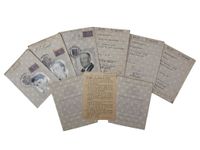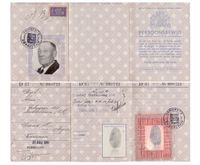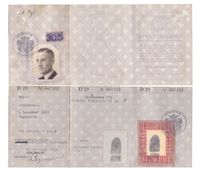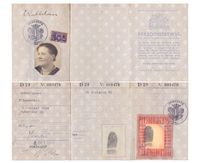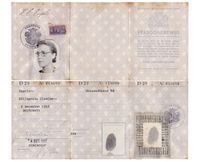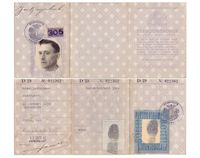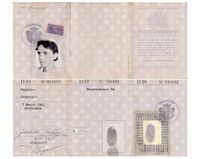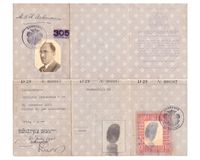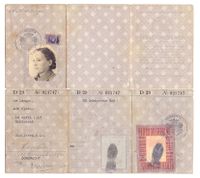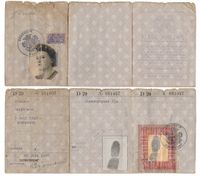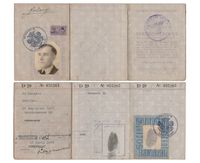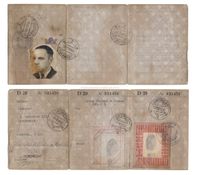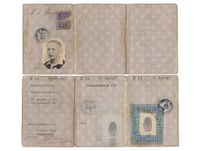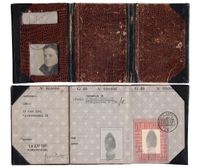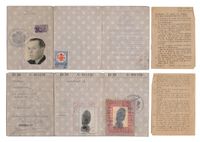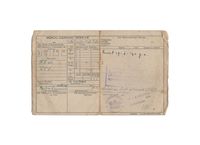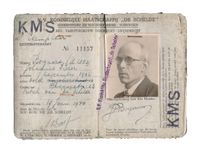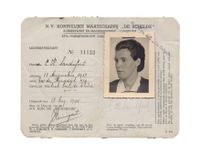Personal Identification Cards.
The personal identity card or "Persoonsbewiijs" is an integral part of the history of the Second World War. The development of the identity card had already begun in 1939. Mr. J.L. Lentz was the inventor of the identity card as it was introduced during the war. In 1932, Lentz became the head of the National Inspection of Population Registers. In 1936, he issued the Population Registers Decision of 1936. As a result, it became mandatory for every municipality to maintain a separate identity card with general information for each resident, starting from July 1st, 1936. However, this was not enough for Lentz as he wanted a system where every citizen would have to identify themselves at any given moment.
The proposal for this system was rejected by the Cabinet-de Geer II in March 1940. Therefore, the identity card would not be implemented before the outbreak of the war. After the capitulation in May 1940, the German Sicherheitspolizei quickly discovered that there was no identification document in the Netherlands with a photo of the holder. In Germany, they had the "Kennkarte," but in the Netherlands, apart from a distribution card without a photo, there was nothing. As the Germans were certainly interested in having a general identification document for every Dutch citizen, they contacted the Dutch Secretary-General of Justice. That was Mr. Tentink, and he wrote a letter to his pro-German counterpart, Karel Johannes Frederiks, the Minister of Internal Affairs. And so, the task of creating the identity card fell back to Lentz. Lentz was convinced that Germany would win the war, so he diligently started working on it. He not only simply created an identity card, but he also made one that was significantly better than the German "Kennkarte." Additionally, he provided the Germans with information about both non-Jewish and Jewish Dutch citizens. An overzealous Dutch official, without fully realizing the societal consequences, ensured that the Germans would have complete control over the population. These very tragic developments later made it effortless for the Germans to identify who was Jewish and who would thus be deported.
On March 1, 1941, the identity card was introduced. Issuing of the identity cards began in April 1941, and from January 1, 1942, every resident of the Netherlands was required to carry the identity card. In the summer of 1941, each identity card held by Jewish citizens was also stamped with two "J"s, another idea of Lentz. Combined with the yellow Star of David that every Jewish citizen was required to wear on their clothing starting from May 3, 1942, it became nearly impossible to escape deportation. The resistance made many attempts to forge the identity cards, but they were never entirely successful.
Lentz received only a three-year prison sentence after the war, despite the fact that his diligent work made it easier for the Germans to deport and murder hundreds of thousands of Jews, as well as potentially harm thousands of other Dutch citizens in different ways.
The personal identity card: a Dutch invention, gratefully implemented by the Germans. *1
Personal identity cards Dordrecht.
Below you will find some examples of personal identity cards from citizens in the Dordrecht region. These images show both the front and back of the identity card. You can click on the photo to enlarge the view.
Identification card Zwijndrecht.
Below you will find an example of an identification card of a citizen from Zwijndrecht. It is an image of both the front and the back of the identification card. You can click on the photo to enlarge the view.
Persoonsbewijs 's Gravendeel.
Below you will find an example of an identification card of a citizen from 's Gravendeel. It is an image of both the front and back of the identification card. What is interesting about this identification card is that it is in a protective cover. There have been many variations of these protective covers. You can click on the photo to enlarge the view.
Instructions to be observed regarding the identification card.
Below you will find instructions for the user of the identification card. These are rules that had to be followed regarding the use of the identification card. The holder was obligated to keep these instructions with the identification card.
Personal Identification Document for Mr. Adrianus Poots and his wife Arjaantje 't Jong - Dordrecht.
Adrianus Poots's personal identification document has a fire department seal indicating that he was a firefighter with the Air Protection Service. His wife's personal identification document is also distinctive. The photo is placed upside down.
Other Identity cards.
Vorläufiger Fremdenpass of Anthonie Ploegers, Dordrecht.
This Vorläufiger Fremdenpass belonged to Anthonie Ploegers from Dordrecht. He was born on September 16, 1916, in Dordrecht and worked as a gardener. The Vorläufiger Fremdenpass was a temporary passport issued by the German authorities to foreigners during World War II. It served as an identification document for individuals who did not hold German nationality, such as forced laborers, refugees, or other displaced persons. This document contained personal details, including name, date of birth, occupation, and physical characteristics, and was often required to be carried at all times. The passport was typically issued in areas where foreigners worked or resided, such as within Germany itself or occupied territories. It was intended to monitor and record the movements and identity of these individuals.
The document also includes an A.E.F. D.P. Registration Record. The A.E.F. D.P. Registration Records (Allied Expeditionary Force Displaced Persons Registration Records) were documents created after World War II to manage the registration of displaced persons (D.P.s). These displaced individuals were often survivors of concentration camps, forced laborers, or refugees who had lost their homes due to the war. The registration cards contained important information, such as:
- Medical examinations and health status.
- Personal details, including name, date of birth, and nationality.
- Travel and residence history, including camps or locations where the person had stayed.
- Purpose of registration, such as resettlement, family reunification, or return to their homeland.
These documents were crucial in coordinating aid, tracing family members, and supporting resettlement programs. They were often prepared by military and humanitarian organizations, including Allied forces and the Red Cross.
Identification card - Koninklijke Maatschappij de Schelde.
Below is an identification card from the N.V. Koninklijke Maatschappij de Schelde, specifically from the aircraft construction department in Dordrecht/Zwijndrecht. The identification card is issued to Mr. Johannes Pieter Bogaard, who resided at Boeroestraat 23 in Dordrecht at the time. The identification card was issued on June 19, 1944. Initially, the Koninklijke Maatschappij de Schelde started as a shipyard, primarily engaged in shipbuilding and repairs. However, they also manufactured other products such as machinery, boilers, engines, steam turbines, aircraft, and light metal products. During the 1930s, the company expanded its focus to include aircraft construction. A separate aircraft construction department was established in Dordrecht, initially involved in the production of recreational aircraft. The department was located at Kilkade. During World War II, they manufactured parts for the Dornier Do 24K flying boat, specifically wings, engine nacelles, and fuel tanks. The aircraft were then assembled at Aviolanda in Papendrecht. These identification documents were introduced to prevent unauthorized persons from gaining access to the factory, thereby making sabotage more difficult. *2
Identification card - Koninklijke Maatschappij de Schelde.
Below is an identification card from the N.V. Koninklijke Maatschappij de Schelde, specifically from the aircraft construction department in Dordrecht/Zwijndrecht. The identification card is issued to Madam C.H. Landifort, who resided at Ringdrijk 410 in Zwijndrecht at the time. The identification card was issued on August 18, 1944. Initially, the Koninklijke Maatschappij de Schelde started as a shipyard, primarily engaged in shipbuilding and repairs. However, they also manufactured other products such as machinery, boilers, engines, steam turbines, aircraft, and light metal products. During the 1930s, the company expanded its focus to include aircraft construction. A separate aircraft construction department was established in Dordrecht, initially involved in the production of recreational aircraft. The department was located at Kilkade. During World War II, they manufactured parts for the Dornier Do 24K flying boat, specifically wings, engine nacelles, and fuel tanks. The aircraft were then assembled at Aviolanda in Papendrecht. These identification documents were introduced to prevent unauthorized persons from gaining access to the factory, thereby making sabotage more difficult. *2
©2017-2026 :Https://www.Dordrechtindeoorlog.nl: ( There is a copyright on the content of this website. This content is not to be shared, duplicated or published withouth the explicit permission of the author of this website. If you have any requests you can email to: Info@Dordrechtindeoorlog.nl or look on : www.dordrechtindeoorlog.nl/termsofuseforthecontentonthiswebsite.
*1 Source: The explanation and information regarding the identification card have been gratefully sourced from the website www.persoonsbewijzen.nl by Mr. Matthijs de Die le Clercq.
*2 Source: www.wikipedia.nl
